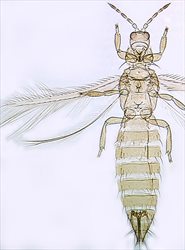
Female
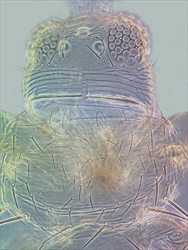
Head & pronotum
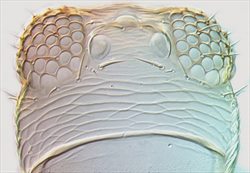
Head
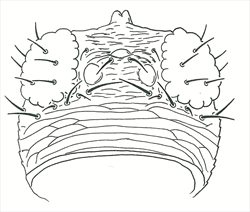
Head

Antenna
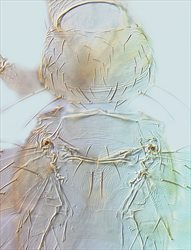
Pro, meso & metanota
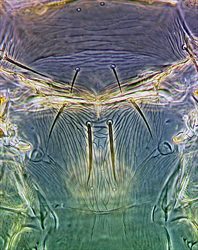
Meso & metanota
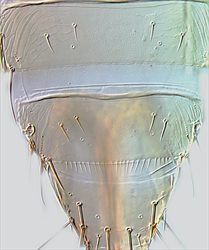
Tergites VII–IX
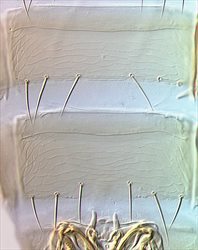
Sternites VI–VII

Fore wing
Both sexes fully winged. Body and legs yellow, major setae light brown; antennal segments IV–V brown distally, VI–VII brown; fore wings pale. Antennae 7-segmented; segments III–IV each with short forked sense cone; VII short. Head wider than long, with two pairs of ocellar setae; pair III small, arising within the ocellar triangle behind the first ocellus; postocular setae pair I slightly longer than ocellar setae III. Pronotum with 2 pairs of long posteroangular setae; posterior margin with 3 pairs of setae. Metanotum with irregular longitudinal lines not strongly converging at the posterior margin, at anterior with curving transverse lines; median setae arising behind anterior margin; campaniform sensilla present. Fore wing first vein with 3 (sometimes 2) setae on distal half; second vein with row of about 15 setae. Abdominal tergite II with 4 lateral marginal setae; tergites V–VIII with paired ctenidia laterally, on VIII posteromesad to spiracles; tergite VIII posteromarginal comb complete, microtrichia long and slender, discal setae S1 as long as setae S2; tergite IX with 2 pairs of campaniform sensilla, X with median split; pleurotergites without discal setae. Sternites without discal setae.
Male smaller than female; tergite VIII with marginal comb complete medially; sternites III–VII with narrow transverse pore plate.
The genus Thrips is the second largest genus in the Thysanoptera, and currently includes, worldwide, over 290 species. All members of genus Thrips lack ocellar setae I on the head, and they all have ctenidia on tergite VIII posteromesad to the spiracles. Other characters, such as number of antennal segments, number of setae on the fore wing veins, and number of discal setae on the sternites are variable between species (Palmer, 1992; Nakahara, 1994; Mound & Masumoto, 2005). Thrips flavus is remarkably similar in structure to the invasive pest species from Asia, T. palmi, but has ocellar setae III arising inside the ocellar triangle behind the first ocellus, and the longitudinal sculpture on the metanotum scarcely converges at the posterior margin
Polyphagous across its range, but in Britain often found in the flowers of Ulex [Fabaceae] (Morison, 1968a). In mid-summer, adults are likely to be encountered in the flowers of numerous plant species.
Recorded throughout Britain from Kent to Caithness (Mound et al., 1976), and from both Northern Ireland as well as the Republic of Ireland (O'Connor, 2008). This species is abundant and widespread throughout Eurasia from Britain to China, Korea, Japan and Malaysia (Mound & Azidah, 2009; Mirab-balou et al., 2011). Contrary to several published references, the species has not been recorded from North America.
THRIPIDAE - THRIPINAE
Thrips flavus Schrank
Thrips flavus Schrank, 1776: 31
Thrips melanopa Schrank, 1776: 31
Thrips ochraceus Curtis, 1841: 228
Physothrips flavidus Bagnall, 1916: 399
Thrips flavidus Bagnall, 1916: 402
Thrips flavosetosus Priesner, 1919: 105
Thrips obscuricornis Priesner, 1927: 423
Physothrips flavus Bagnall, 1928: 98
Taeniothrips clarus Moulton, 1928: 287
Thrips kyotoi Moulton, 1928: 302
Thrips nilgiriensis Ramakrishna, 1928: 262
Taeniothrips luteus Oettingen, 1935: 183
Taeniothrips sulfuratus Priesner, 1935: 358
Thrips biarticulata Priesner, 1935: 358
Taeniothrips saussureae Ishida, 1936: 70
Taeniothrips rhopalantennalis Shumsher, 1946: 181
Mirab-balou M, Tong X, Feng J & Chen X (2011) Thrips (Thysanoptera) of China. Check List 7: 720–744.
Morison GD (1968a) Observations and records for some British Thysanoptera. VII Thripidae, Thrips flavus Schrank and Thrips brevicornis Priesner. The Entomologist 101: 205–212.
Mound LA & Azidah AA (2009) Species of the genus Thrips (Thysanoptera) from Peninsular Malaysia, with a checklist of recorded Thripidae. Zootaxa 2023: 55–68.
Mound LA & Masumoto M (2005) The genus Thrips (Thysanoptera, Thripidae) in Australia, New Caledonia and New Zealand. Zootaxa 1020: 1–64.
Mound LA, Morison GD, Pitkin BR & Palmer JM (1976) Thysanoptera. Handbooks for the Identification of British Insects 1 (11): 1–79.
Nakahara S (1994) The genus Thrips Linnaeus (Thysanoptera: Thripidae) of the New World. United States Department of Agriculture. Technical Bulletin 1822: 1–183.
O’Connor JP (2008) A review of the Irish thrips (Thysanoptera). Irish Naturalists’ Journal 29: 20–24.
Palmer JM (1992) Thrips (Thysanoptera) from Pakistan to the Pacific: a review. Bulletin of the British Museum (Natural History) Entomology Series 61 (1): 1–76.